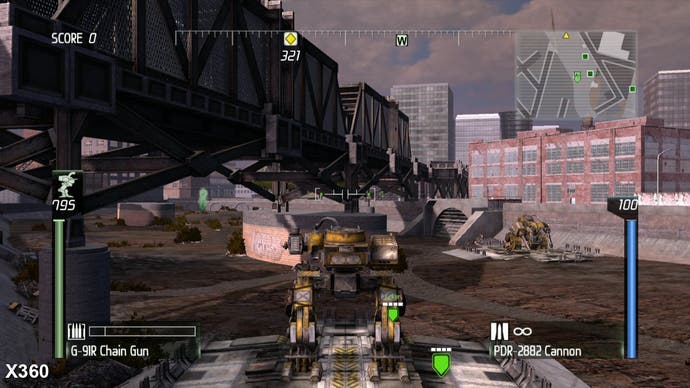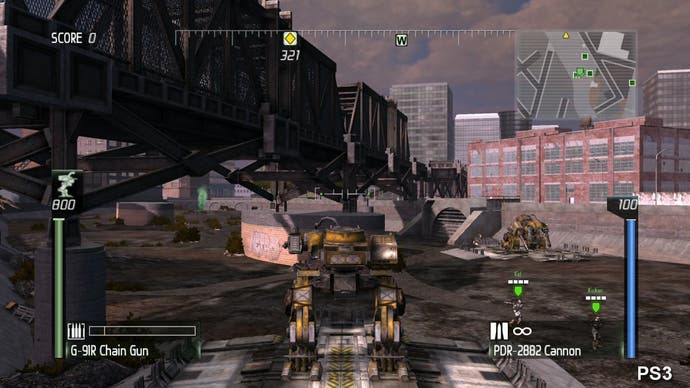Face-Off: EDF: Insect Armageddon
Sony Defense Force.
| - | Xbox 360 | PlayStation 3 |
|---|---|---|
| Disc Size | 4.6GB | 4.5GB |
| Install | 4.6GB (optional) | - |
| Surround Support | Dolby Digital | Dolby Digital, DTS, 5.1LPCM |
Never mind the graphics, it's all about the gameplay. Just like its predecessors, Earth Defense Force: Insect Armageddon eschews the traditional technological arms race associated with contemporary console shooters in favour of a unique approach to the genre: overwhelm players through the sheer numbers of enemies on-screen at any given point, and satisfy the senses with an orgy of all-out destruction.
Fans may be concerned by the changes made behind the scenes since the release of Earth Defense Force 2017: Japanese studio Sandlot has relinquished coding duties, with US developers Vicious Cycle drafted in to create the new game using its own Vicious Engine 2. Not much is really known about this technology - the original Vicious Engine has been used on a handful of titles for the PS2, Wii and PSP and the engine has only had limited exposure on the HD consoles prior to the release of Insect Armageddon.
The good news is that Vicious Cycle "gets" what EDF is all about, the gameplay remains as compelling and mindlessly enjoyable as it ever has been and while the graphics are hardly state-of-the-art, Vicious Engine 2 does a good enough job for the tasks it is appointed for: specifically, rendering legions of insectoid vermin to destroy and providing a basic cityscape to raze to the ground in the course of the battle, while maintaining a fairly solid frame-rate.
The question is, with an engine that is seemingly unproven on the HD consoles, how does Earth Defense Force: Insect Armageddon fare on Xbox 360 and PlayStation 3? Has Vicious Cycle achieved platform parity on its first attempt? Here's the requisite head-to-head video, backed up by a meaty comparison gallery.
Covering off the basics, EDF: Insect Armageddon is operating at native 720p resolution on both platforms but with differences in the anti-aliasing implementation. Standard 2x multi-sample anti-aliasing is utilised on the Xbox 360, while the detail-blurring quincunx is wheeled out for the PlayStation 3 game. While we've been critical of QAA in the past, it's difficult to fault its usage here: the art style doesn't rely on intricate artwork so the blur effect is really very slight and barely impactful on overall image quality. Indeed, the additional coverage QAA has in terms of edge-smoothing actually seems to give the PS3 version a slight advantage here.
In most other respects, there's very little difference between the two versions, aside from the odd bit of flicker on trees (we saw this mostly on 360) where the engine appears to be struggling to the sort leaves properly according to depth. In truth, when it comes to the rendering basics, Insect Armageddon isn't exactly a great-looking game. Shadows are low resolution on both platforms and don't appear to be dithered or hard-edged, but fade-in distance does appear to be a bit of an issue on the Xbox 360 version.
Texture filtering seems to be identical on both games, but it is fairly poor overall with the detailing on the ground descending into a blur very close to the player. Screen space ambient occlusion (SSAO) has been implemented on both Xbox 360 and PS3 games, manifesting as a thick, viscous smudge surrounding player and enemies when they are particularly close to scenery. In this respect we are reminded of the heavy-handed utilisation of the effect as we saw it in Homefront and the PS3 version of L.A. Noire.




In some cases, where there are differences between the two games, it does point to a series of small presentational or technological advantages to PS3. Certain textures on incidental detail (such as a chain fence) appear to be cleaner and clearer on the Sony platform, for example. In terms of view distance, the two versions look very close indeed, but LODs appear to be marginally superior on PS3. It's not really a big deal, and the difference is only really picked up in direct A to B comparisons - there's no impact at all on the gameplay.
Looking at the Vicious Engine website, the developers talk about platform parity and the ability to "convert your game" to both consoles with the press of a button. The overall sense you get from EDF: Insect Armageddon is that the project (or perhaps the engine) led on PlayStation 3: generally speaking it just seems to be that little bit more polished than what we see on the Xbox 360 "conversion".
In terms of basic performance, Insect Armageddon seems to be mostly like-for-like across both consoles - on the face of it, at least. The game is capped at 30 frames per second and there is no noticeable tearing whatsoever (PS3 can tear a little in the top few lines, obscured by overscan on most HDTVs, but practically invisible even if you have a full 1:1 display). The game appears to be double-buffered, displaying one image while rendering the other, then flipping the framebuffer and repeating the process.



